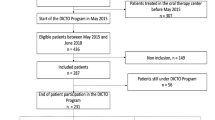Abstract
Oral targeted therapies have become central in the management of advanced cancer since they delay the progression of the disease and extend overall survival of the patients. Targeted therapies, despite inducing some dramatic response, rarely eradicate cancer but rather switch it to a chronic state. This implies that the treatments are taken chronically over several months or years with consequences on compliance. This is of particular importance since these drugs have also specific side effects that can greatly affect patients’ quality of life. In the present chapter, the main side effects of targeted therapies, their management from the angle of specialised nursing care, and several prophylactic measures have been reviewed. The nurse indeed plays a critical role in guiding and supporting patients receiving oral treatments. A multidisciplinary and multi-professional approach involving physicians, pharmacists, and paramedical staff guarantees a better efficiency. In addition, properly educated patients will improve their adherence to treatment.
Access this chapter
Tax calculation will be finalised at checkout
Purchases are for personal use only
Similar content being viewed by others
References
Adherence to long-term therapies: evidence for action. Available from www.who.int/chp/knowledge/publications/adherence_full_report.pdf
Mikael D. Chimiothérapie orales: Mythes et réalités, centre Henri Bequerel, Rouen. 2010. https://onconormandie.fr/wp-content/uploads/2017/05/Chimiotherapie-orale-adherence-M.Daouphars.pdf
Goodin S, Griffith N, Chen B, Chuk K, Daouphars M, Doreau C, et al. Safe handling of oral chemotherapeutic agents in clinical practice: recommendations from an international pharmacy panel. J Oncol Pract. 2011;7(1):7–12.
National Cancer Institute Common Terminology Criteria for Adverse Events (CTCAE) version 3.0. Available from http://ctep.cancer.gov/protocolDevelopment/electronic_applications/docs/ctcaev3.pdf. Accessed 16 Mar 2009.
Targeted Therapy, American Society of Cancer. Available from https://www.cancer.org/treatment/targeted-therapy.htlm
Dicato MA, editor. Side effects of medical cancer therapy. p. 388. https://doi.org/10.1007/978-0-85729-787-7_10.
Autier J, Escudier B, Wechsler J, Spatz A, Robert C. Prospective study of the cutaneous adverse effects of sorafenib, a novel multikinase inhibitor. Arch Dermatol. 2008a;144(7):886–92.
Lacouture ME, Tsao AS, Oishi K. Strategies for rash management: an expert-guided discussion for nurses. ONS Connect. 2010;25:47–8.
Autier J, Mateus C, Wechsker J, Spatz A, Robert C. Cutaneous side effects of Sorafenib and sunitinib. Ann Dermatol Venereol. 2008b;135(2):148–53;quiz 147, 154.
Dicato MA, editor. Side effects of medical cancer therapy. p. 385–6. https://doi.org/10.1007/978-0-85729-787-7_10.
Ocvirk J, Heeger S, McCloud P, Hofheinz RD. A review of the treatment options for skin rash induced by EGFR-targeted therapies: evidence from randomized clinical trials and a meta-analysis. Radiol Oncol. 2013;47:166–75.
Robert C, Soria J-C, Spatz A, Le Cesne A, Malka D, Pautier P, et al. Cutaneous side effects of kinase inhibitors and blocking antibodies. Lancet Oncol. 2005;6(7):491–500.
Dicato MA, editor. Side effects of medical cancer therapy. p. 397–8. https://doi.org/10.1007/978-0-85729-787-7_15.
Mario E, Lacouture ME. The growing importance of skin toxicity in EGFR inhibitor therapy. Oncology (Williston Park). 2009;23(2):194–6.
Dicato MA, editor. Side effects of medical cancer therapy. p. 399–400. https://doi.org/10.1007/978-0-85729-787-7_15.
Braiteh F, Kurzrock R, Johnson FM. Trichomegaly of the eyelashes after lung cancer treatment with the epidermal growth factor receptor inhibitor erlotinib. J Clin Oncol. 2008;26:3460–2.
Scheinfeld N. Imatinib mesylate and dermatology part 2: a review of the cutaneous side effects of imatinib mesylate. J Drugs Dermatol. 2006;5(3):228–31.
Dicato MA, editor. Side effects of medical cancer therapy. p. 483. https://doi.org/10.1007/978-0-85729-787-7_15.
Dicato MA, editor. Side effects of medical cancer therapy. p. 485. https://doi.org/10.1007/978-0-85729-787-7_15.
Ederhy S, Cohen A, Dufaitre G, Izzedine H, Massard C, Meuleman C, et al. QT interval prolongation among patients treated with angiogenesis inhibitors. Target Oncol. 2009;4(2):89–97.
Maitland ML, Kasza KE, Karrison T, Moshier K, Sit L, Black HR, et al. Ambulatory monitoring detects sorafenib-induced blood pressure elevations on the first day of treatment. Clin Cancer Res. 2009;15(19):6250–7.
Van der Veldt AAM, de Boer MP, Boven E, Eringa EC, van den Eertwegh AJM, van Hinsbergh VW, et al. Reduction in skin microvascular density and changes in vessel morphology in patients treated with sunitinib. Anti-Cancer Drugs. 2010;21(4):439–46.
Dicato MA, editor. Side effects of medical cancer Therapy. p. 515–6. https://doi.org/10.1007/978-0-85729-787-7_6.
Dicato MA, editor. Side effects of medical cancer therapy. p. 277. https://doi.org/10.1007/978-0-85729-787-7_6.
Bjordal JM, Bensadoun RJ, Tuner J, Frigo L, Gjerde K, Lopes-Martins RA. A systematic review with meta-analysis of the effects of low-level laser therapy (LLLT) in cancer therapy-induced oral mucositis. Support Care Cancer. 2011;19(8):1069–77.
Hapani S, Chu D, Wu S. Risk of gastrointestinal perforation in patients with cancer treated with bevacizumab: a meta-analysis. Lancet Oncol. 2009;10(6):559–68.
BCCA guidelines for management of chemotherapy-induced diarrhea. Available from www.bccancer.bc.ca/nursing-site/Documents/GuidelinesforManagementofCDI.pdf
Benson AB, Ajani JA, Catalano RB, Engelking C, Kornblau SM, Matrenson JA Jr, et al. Recommended guidelines for the treatment of cancer treatment-induced diarrhea. J Clin Oncol. 2004;22(14):2918–26.
Lim SL, Ang E. Validity and reliability of nutrition screening administered by nurses. Sage Journals. First published October 9, 2013.
Vellas B, Guigoz Y, Garry PJ, Nourhashemi F, Bennahum D, Lauque S, Albarede JL. The Mini Nutritional Assessment (MNA) and its use in grading the nutritional state of elderly patients. Nutrition. 1999;15(2):116–22.
Nitenberg G, Raynard B. Nutritional support of the cancer patient: issues and dilemmas. Crit Rev Oncol Hematol. 2000 Jun;34(3):137–68.
Joly F. Renal carcinoma and fatigue: which challenge in the era of antiangiogenic drugs. Bull Cancer. 2011;98(9):1071–81. https://doi.org/10.1016/j.ijrobp.2010.06.037.
Dicato MA, editor. Side effects of medical cancer therapy. p. 278–9. https://doi.org/10.1007/978-0-85729-787-7_6.
Horne R. Compliance, adherence and concordance. In: Taylor KMG, Harding G, editors. Pharmacy practice. London: Taylor & Francis; 2001.
NICE Medicines Adherence guidelines. 2009. Available from https://www.nice.org.uk/guidance/cg76/evidence/full-guideline-242062957
Claxton AJ, Cramer J, Pierre C. A systematic review of the associations between dose regimens and medication compliance. Clin Ther. 2001;23(8):1296–310.
McCue DA, Lohr LK, Pick AM. Improving adherence to oral cancer therapy in clinical practice. Pharmacotherapy. 2014;34(5):481–94.
MASCC Oral Agent Teaching Tool (MOATT). Available from www.mascc.org/assets/documents/moatt_userguide.pdf
NCCN Distress thermometer and problem list for patients. Available from https://www.nccn.org/patients/resources/life_with_cancer/pdf/nccn_distress_thermometer.pdf
Author information
Authors and Affiliations
Corresponding author
Editor information
Editors and Affiliations
Rights and permissions
Copyright information
© 2019 Springer Nature Switzerland AG
About this chapter
Cite this chapter
Remacle, C. (2019). The Patients’ Journey with Targeted Therapies. In: Charnay-Sonnek, F., Murphy, A. (eds) Principle of Nursing in Oncology . Principles of Specialty Nursing. Springer, Cham. https://doi.org/10.1007/978-3-319-76457-3_4
Download citation
DOI: https://doi.org/10.1007/978-3-319-76457-3_4
Published:
Publisher Name: Springer, Cham
Print ISBN: 978-3-319-76456-6
Online ISBN: 978-3-319-76457-3
eBook Packages: MedicineMedicine (R0)




